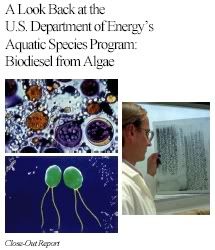http://www.nanostring.net/Algae/CaseStudy.pdf
and here the response and follow-up discussions:
http://www.nanostring.net/Algae/CaseStudyFollowup.pdf
This study evaluates the claims made by GreenFuel Technology Corporation (www.greenfuelonline.com) and makes some very interesting reading. The basic conclusion is that using Algae Bioreactors for producing Biodiesel will only be competitive if the oil price hits over US$800 per barrel, in the best case!
Using physics theories and comparing this to the claims made by GreenFuel you will find statements like this in the report:
"As can be seen from Table 1, the maximum biodiesel yield from the S.W. USA is less than 1.5 gal/yr/m2. According to a construed example in GreenFuel’s patent application, an algal plant generates 342,000 bbl of biodiesel per year in a 1.3km2 area, which would translate into 11 gal/m2/yr. Given biodiesel’s energy content of 126,200BTU per gallon, this would equal to energy capture of 46.6W/m2 for a region with mean annual PAR levels of 105W/m2, or in other words a Q of 44.4%! Considering that the theoretical efficiency of photosynthesis is 27%, this claim is an unconscionable exaggeration that may get GreenFuel in trouble with the patent office."
I am a businessman and an entrepreneur not a scientist so of course I can not comment on this report but if the report is correct it is another indication to the problems associated to the Algae Bioreactors and seriously questions the viability of such ventures. I estimate that there are at least 10 start-ups experimenting with this technology with a total funding exceeding US$100M.
Previous research, most prominently the so-called "Aquatic Species Program" (ASP), which ran from 1978 to 1996 under the US National Renewable Energy Laboratory (NREL), funded by the Office of Fuels Development, a division of the US Department of Energy. The program's conclusions (download .pdf) about the Algae BioReactor are:

"The Japanese, French and German governments have invested significant R&D dollars on novel closed bioreactor designs for algae production. The main advantage of such closed systems is that they are not as subject to contamination with whatever organism happens to be carried in the wind. The Japanese have, for example, developed optical fiber-based reactor systems that could dramatically reduce the amount of surface area required for algae production. While breakthroughs in these types of systems may well occur, their costs are, for now, prohibitive—especially for production of fuels. DOE’s program focused primarily on open pond raceway systems because of their relative low cost."
NREL's ASP research abandoned Algae Bioreactors all together and instead focused on the development of algae farms in desert regions, using shallow salt water pools for growing the algae.
Biopact (http://www.biopact.com/) has always taken a sceptic view towards Algae-2-Biofuel which you can read here and in this very long but worth reading article here. There is also an article with Dr. Krassen Dimitrov here.
If you would like to continue researching and know future developments subscribe to his blog here.
Per Dahlen
Singapore
26_APR-2008

No comments:
Post a Comment